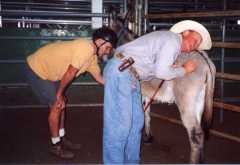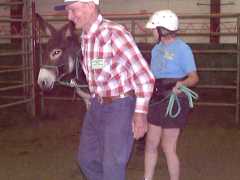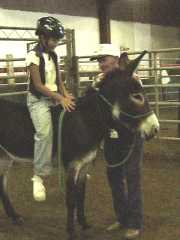"Gentling Wild Donkeys-
|
"And then the feed comes out here..."
|
| GETTING UNDER WAY |
OBJECTIVE: Halter the DonkeyOnce the donkey is no longer afraid, it's time to halter him. One of the approaches we prefer is to let the donkey get used to the feel of the rope and halter before putting it on. We usually use a quick halter or squeeze halter which is tied on the animal using a soft rope. Since donkeys naturally lean into pressure, it is important for us to be able to control the size and feel of the halter until we are ready to teach the donkey to lead. Before the halter is tight around the donkey's nose, we want him to learn to To do this we start with gentle tugs and releases until the donkey figures out that what works best is to face the handler when the halter is tugged. In the image on the right, 87 year old John Sharp is working with a good sized burro fresh out of the BLM adopten pen. Finesse is more important than strength. |
Controlling nose pressure
|
|
Once the donkey starts to understand the pressure from the halter, it is time to
teach him to yield to pressure exerted on the lead line. Trying to pull a donkey
forward will usually just result in him setting back on the line. Asking the
donkey to come sideways provides more leverage and is easier on the donkey.
In the image on the right, John Sharp is asking the donkey to come toward him. Note that he is also still scratching the donkey on the neck in order to maintain a "buddy" mind set in the mind of the donkey. |
Asking the donkey to step in
|
| Some donkeys will appreciate rubs or scratches as rewards for a correct response. Others may need more oral gratification as positive reinforcement. If we use treats in training, we usually like to use them in the context of clicker training in order to prevent the animal from regarding us merely as a walking buffet. | |
OBJECTIVE: Get the Donkey to LeadOnce the donkey yields to pressure it is time to ask the donkey to walk forward. Some domkeys will naturally follow the handler. Others may need a bit of encouragement at first. Getting into a pulling contest with a very strong 400 pound animal usually only teaches the donkey that he is stronger than the handler. We ask the donkey to start out with the familiar tug to the side. Once the donkey is in motion, a second person can apply some energy from behind to "help" the donkey follow the handler. Once the donkey gets the idea, everyone can move together in a small band. Leading activities should be quiet and friendly. |
Pat Fredrickson assists
|
OBJECTIVE: Get On the DonkeyDonkeys who enjoy pleasant relationships with humans generally don't seem to be too bothered by people on their backs. They typically don't buck or run off. Mounting a donkey for the first time still should be a carefully considered and organized activity, with lots of moral support provided to the donkey. If the handler is familiar to the donkey and the rider is quiet, first rides on donkeys are usually uneventful. Mounting should still take place in a safe place and the rider should wear appropriate protective gear. The handler can provide "moral support" to the donkey and lead the animal through the first few riding sessions. |
A young girl gets a ride on
|
|
Continue to Part FourReturn to Part TwoPress "Back" to return to the page which brought you hereReturn to KBR Training SectionReturn to KBR World of Wild Horses & BurrosReturn to LRTC Wild Horse MentorsGo To
| |





